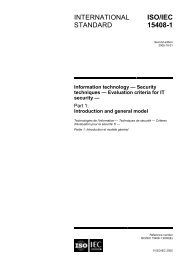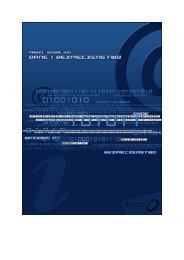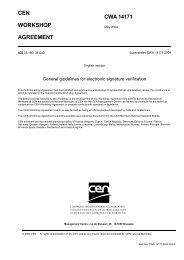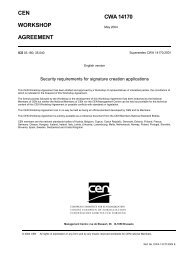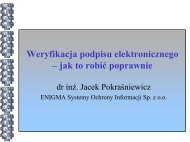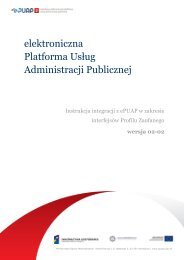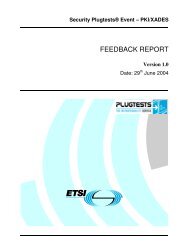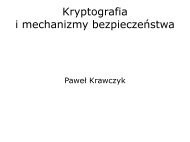When electronic signature becomes a information services ... - IPSec
When electronic signature becomes a information services ... - IPSec
When electronic signature becomes a information services ... - IPSec
Create successful ePaper yourself
Turn your PDF publications into a flip-book with our unique Google optimized e-Paper software.
ZUS, an example of QES misunderstanding<br />
ZUS, the Polish social insurance operator, introduced the digital <strong>signature</strong> in 1999, because it<br />
built a system that allowed companies to submit employee declarations <strong>electronic</strong>ally. It was<br />
initially based on X.509 certificates issued by an external Certification Authority on behalf of<br />
ZUS. The certificate was assigned to a company as a whole, it was software based (no smart<br />
card) and issued to companies for free. No design documents were ever published, but it<br />
seemed to work and to be close to an optimal compromise between security and usability.<br />
In 2005, for reasons that have never been precisely explained, the government decided that<br />
ZUS would switch over to using qualified <strong>electronic</strong> <strong>signature</strong>s. Obviously, the 200,000<br />
companies that used to send their declarations to ZUS for free would have to pay for the<br />
certificate. In 2007, just before the conversion, there were less than 10,000 active qualified<br />
certificates sold by Polish certification centres, most of which were bought by the public<br />
administration or organisations that were required to use QES by law in some part of their<br />
activities (for example, notaries and banks).<br />
After the conversion, as a perfect example of market created by the government, the rush for<br />
qualified certificates started in 2008 and reached around 200,000 certificates, where it is now. 59<br />
Contrary to what the people that advocated the use of qualified <strong>electronic</strong> <strong>signature</strong>s predicted,<br />
this enforced ‘stimulus’ did not cause an increase in interest among individuals, even if the ESP<br />
gateways mentioned above already existed (neither did it cause a predicted decline in the prices<br />
of qualified certificates). The estimated cost of the conversion for the private sector – ignored<br />
by most people speaking on this subject – was between 15 and 24 million euro, with an<br />
additional cost of 10 million euro annually. The cost of the conversion for ZUS is unknown.<br />
The decision caused an avalanche of problems, apparently never predicted by whoever made<br />
the decision. First, the QES is associated with an individual person. For business continuity<br />
purposes, companies were advised to buy not one, but several certificates to ensure the<br />
declarations can be still sent if someone is not available because they are on leave, sick or<br />
otherwise not available. Large companies had to buy several certificates, to the amusement of<br />
companies selling certificates. Small companies did the opposite. To save money, they had one<br />
certificate, and everyone knew the password, making the whole QES model look like an<br />
amusing spectacle for laughter.<br />
Second, a QES is issued to a named individual, so there is an assumption that when the QES is<br />
used, it was the person whose QES it is, who caused the <strong>signature</strong> to be affixed to the data.<br />
59<br />
Unizeto, ‘Kalendarium e-podpisu w Polsce’, 2009.



